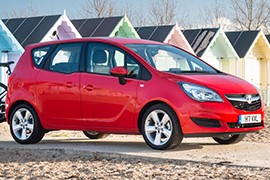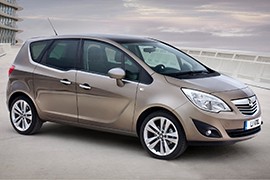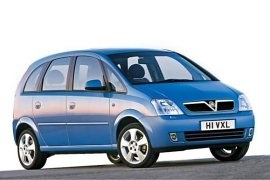VAUXHALL Meriva Models/Series Timeline, Specifications & Photos
First production year: 2003
Engines: Diesel, Gasoline, Natural gas
Body style: Van
When Vauxhall Meriva was launched in 2003, the small MPV was the only vehicle in that car-segment. It re-opened that car category.
After the successful Vauxhall Zafira compact MPV, with seating for up to seven passengers, the car-maker tried a smaller vehicle: the Meriva. It was based on the small Vauxhall Corsa. With a raised greenhouse, it could carry up to five people inside, along with their luggage. The first generation was sold in more than 115.000 units in the U.K., and more than one million in the European version, Opel Meriva.
The second generation was also based on a modified Corsa platform, with bigger wheelbase and parts taken from the bigger models such as the Vauxhall Astra and Insignia and, in 2014, the car received a refreshed version, with up-to-date engines according to the Euro 6 pollution norms. The car featured LED daytime running lights and rear LED taillights. It also introduced 18” light-alloy wheels, which were very rare in the segment.
Inside, the rear passengers could get in and out easier than in the vehicles with normal opening doors, and, on top of that, the car featured a grab handle on the B-pillar to help. Another advantage of the rear-hinged doors is the easy fitting of a child seat in the back and also strapping the safety belt on it. For the top version, the Meriva came equipped with a glass ceiling.
The new engine range featured three power versions for a 1.4-liter gasoline unit and a 1.6-liter turbocharged diesel with three versions for power. The standard transmission was a 5 or 6 gears manual, depending on the engine, while a 6-speed automatic was available at extra cost.
Introduced in 2010 at the Geneva Motor Show, the second generation of the small-sized minivan from Vauxhall brought new ideas to a segment where there were not too many contenders.
General Motors didn't want to give up on the European minivans even though there was a small market for those vehicles. Moreover, Europe and UK were still weakened by the world financial crisis, and the economy was still recovering. But families needed cars, and Vauxhall felt obliged to provide them with the Meriva's second generation, which came with fresh ideas.
With an exterior that reminded customers that the Meriva was linked to the small-sized Corsa, the MPV featured big headlights and a grille with a chromed bar at the top. The bumper's lower grille formed, together with the side scoops, a smiling face. But the most unusual side of the car was its profile. The beltline went upwards until the B-pillars and then took a sudden downward step only to rise again up until the C-pillars. Most importantly, the car featured rear-hinged back doors, easing the ingress and egress of the vehicle.
Inside, the high-mounted seats at the front allowed the designers to create more room for the rear passengers. It looks like this vehicle was mostly made for those seated in the back. The idea was to ease the process of installing a child seat and its content. At the front, GM's design team separated the driver and the passenger area by installing a tall center console extended into the center stack between them.
Under the hood, the Meriva offered a wide choice of six engines, both gasoline, and turbo-diesel. Unfortunately, not all versions were available with an automatic transmission.
Vauxhall introduced the Meriva on the British small-segment market in 2003 to answer the customer's needs for a small yet spacious vehicle.
The small vehicle was based on the Vauxhall Corsa, and unlike its small-segment cousin, it featured an MPV stance with a taller greenhouse. It was meant to provide more interior room while still be lower priced than other minivans on the market. The result was surprisingly good, but the market was already started to shift toward the SUV segment.
At the front, the little MPV showed a black grille adorned by the big, chromed V-shaped Vauxhall's badge decoration. Its headlights were more vertical than longitudinal to create an impression of a taller vehicle. The hood was short and very steep, continued by the A-pillars and windshield. The car featured an unusual number of side windows, four, for such a small vehicle. Despite all the attention to the vehicle's shape, the carmaker didn't consider installing body-colored door handles or mirrors.
Inside, the Meriva offered high-mounted seats at the front with little side support. They were meant to provide easy access. Depending on the trim level and options, the carmaker installed a separate panel for the on-board computer in the middle of the dashboard, while the instrument cluster featured a four-dials layout for main information. The biggest advantage of the Meriva was the interior seat arrangement with a 60/40 split-folding rear bench seatback.
Under the hood, Vauxhall offered a range of five engines, and two of them were turbo-diesels: one supplied by Fiat and the other by Isuzu.


